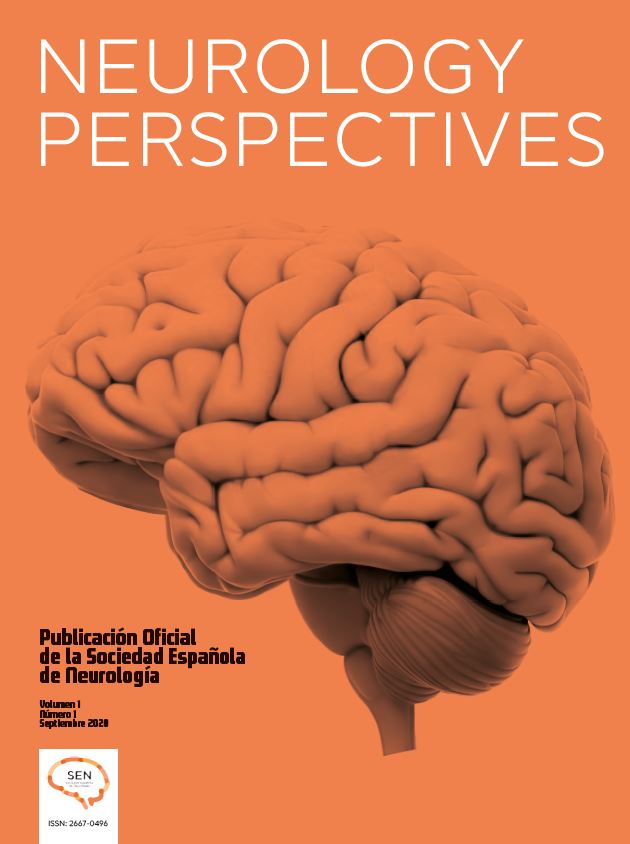Paraneoplastic myopathies are widely described in the literature; several immune and pathological patterns may predict their association with tumours.1
Muscle MRI is increasingly used in the context of neuromuscular diseases; this tool is helpful in the diagnosis of immune-mediated myopathies (IMM) due to its high sensitivity.2,3 Few studies have confirmed its usefulness in patients testing negative for biomarkers of IMM.
We present the case of a patient with aggressive myopathy associated with breast cancer, in whom neither creatine phosphokinase (CPK) levels nor electromyography (EMG), muscle biopsy, or antibody test results supported diagnosis; muscle MRI was the most sensitive tool in this case.
Clinical caseOur patient was a 61-year-old woman with no relevant medical history. She visited our hospital's emergency department due to a 2-month history of asthenia and anorexia. In the previous 10 days, she had also experienced difficulty climbing stairs, combing her hair, and swallowing. She was admitted to hospital. The examination revealed symmetric limb-girdle weakness, inability to stand from a seated position and to walk, and hypoactive reflexes. A laboratory analysis revealed anaemia, mild lymphocytic leukocytosis, and an erythrocyte filtration rate of 49 mm/h. A biochemical study detected dissociated cholestasis, a CPK level of 16 U/L, elevated levels of acute-phase reactants, and a carcinoembryonic antigen level of 170.2 ng/mL. An EMG of the proximal muscles detected no signs of myopathy. Figs. 1 and 2 show results from the MRI study of the thigh muscles. The patient tested negative for antibodies against Mi-2, TIF1-γ, MDA5, NXP2, SAE1, SAE2, Jo-1, PL-7, PL-12, EJ, HMGCoAR, and SRP. A whole-body CT scan revealed right breast cancer; axillary, paratracheal, and hilar adenopathy; lymphangitis carcinomatosa; peritoneal carcinomatosis; and bone metastases. A breast biopsy identified invasive ductal carcinoma with positivity for hormonal receptors. A quadriceps muscle biopsy revealed no signs of necrosis or inflammation, with mild atrophy of type II muscle fibres.
Based on the clinical and imaging findings, the patient was diagnosed with paraneoplastic myositis, and received bolus steroid therapy, followed by oral steroids and immunoglobulins, combined with aromatase inhibitors. She displayed excellent progression at 2 months, with 4+/5 strength in the proximal muscles, and was able to walk independently, hop on one leg, and get up from the floor. Carcinoembryonic antigen and acute-phase reactant levels also decreased.
DiscussionThe subtypes of IMM associated with cancer include processes that are increasingly well-categorised from an immunological, anatomopathological, and clinical viewpoint. Some examples include dermatomyositis associated with anti-TIF1-γ or anti-NXP2 antibodies1 and necrotising myopathies, with rapidly progressive, severe limb-girdle weakness.1,4
We present the case of a woman with aggressive limb-girdle weakness coinciding with a diagnosis of extensive breast cancer. Clinical signs of myopathy were not supported by complementary test results: CPK levels were within the normal range, the EMG study detected no alterations, the patient tested negative for specific antibodies, and a biopsy detected no inflammation or necrosis. Muscle MRI, however, revealed muscle inflammation.
Malartre et al.2 support the use of muscle MRI in the diagnostic workup of IMM, to supplement the information provided by clinical signs, CPK levels, and presence of specific antibodies. The authors describe the technique as a non-invasive, safe, highly sensitive tool enabling morphological analysis and characterisation of the muscle, whose results are immediately available. In a cohort of 36 patients with IMM, Ukichi et al.5 proposed performing MRI studies of the thigh muscles.
Wasserman et al.3 used STIR and proton density fat saturation sequences on the axial and coronal planes, as well as T1-weighted sequences. STIR and DIXON sequences are used to detect oedema, while T1-weighted sequences display muscle atrophy and fatty degeneration.2,3,5
In the case presented here, a thigh MRI scan yielded conclusive results, and treatment was immediately started. The images revealed active inflammation without fatty infiltration.
Ukichi et al.5 describe a distinctive MRI finding of muscular dystrophy: signal hyperintensity in the fascia, peripheral areas of the muscle, and subcutaneous adipose tissue (the latter is not observed in such other IMM as polymyositis), with a typical honeycomb pattern.
In our patient, MRI showed a typical pattern of dermatomyositis,2,3 except that oedema was diffuse. The patient did not present skin lesions, probably due to the early onset of immunomodulatory treatment.
Although anatomical pathology studies constitute the gold-standard for diagnosis and characterisation of IMM,1 this was not the case in our patient; this further supports the diagnostic value of muscle MRI.
ConclusionMuscle MRI supports the clinical diagnosis of IMM, providing immediate results while determining the stage of the disease. We support the routine use of this technique in the diagnostic workup of neuromuscular disorders, especially in patients with negative biopsy results.
Data protectionThe authors observed their centre's protocols for the publication of patient data. The patient gave informed consent for the publication of this case report.
Conflicts of interestThe authors have no conflicts of interest to declare.
FinanciationNone.









